F. Romano
Francesca Romano is a consultant in the Forest Policy Service, Forestry Department, FAO, Rome.
Clear, secure and diversified forest tenure systems are fundamental to sustainable management of community forests, small private forests and family forests.
Forest tenure systems in Africa are characterized mainly by public ownership, with most forests under the direct control and management of government. However, shifts are taking place, in particular to locally rather than State-run forest management. This article, based on a recent study conducted by FAO (see Box, following page) examines some specific examples and analyses enabling and constraining factors for the success of alternative tenure systems. It focuses on those alternative systems that have demonstrated particular success in addressing local needs and supporting sustainable forest management because tenure is secure and appropriate tenure diversification processes are in place, favouring locally based forest management. It reinforces the importance of security of tenure as a building block for sustainable forest management.
Forest tenure is the combination of legally or customarily defined forest ownership rights and arrangements for the management and use of forest resources. Forest tenure determines who can use what resources, for how long and under what conditions. Legally, tenure is a bundle of both rights and obligations: the right to own, hold, manage, transfer or exploit resources and land, but also the obligation not to use these in a way that harms others. Tenurial rights include but are not equivalent to ownership. Absence of full ownership does not preclude the possibility of other tenure rights over a natural resource. Tenure security refers to the assurance, robustness and durability of tenure, and includes the right to exclude others.
In the context of this article, locally based forest management refers mainly to small-scale forestry dealing with the management of community forests, small private forests or family forests. This management system normally implies local decision-making and planning processes taking into account traditional tenure systems (which are often based on common property in Africa, but vary by country in terms of how forests are managed and by which traditional authority), local knowledge and local needs.
While about 85 percent of the world’s forests are publicly owned (FAO, 2006a), it is increasingly apparent that locally based decision-making and tenure security influence the sustainability of forest management (UNDP, UNEP, World Bank and WRI, 2005). Long-term tenure security is necessary to ensure accountability and control of forestry operations at the local level (FAO, 2005). However most poor rural people typically remain poor because their land tenure is insecure (Bruce, 2004). In addition, most current policies and legal frameworks limit access to natural resources by local people. As stressed by Hobley (2007), tenure reform has often been incomplete and restricted, with the State retaining most of the decision-making and control over high-value forests while showing clear limitations in managing them.
Although it is generally accepted that tenure security is important for the development of the forest sector, several questions remain mostly unanswered. To what extent does forest tenure influence land and resource use? Are secure tenure arrangements part of the solution for ending forest degradation and destruction, which continues at an alarming rate (FAO, 2005)? Are there alternative tenure systems to public ownership and public management of forest that can lead to better forest management and improved livelihoods? If such alternatives exist, what are the factors that can enable them to take root?
| Although most of Africa’s forests are State owned and managed, tenure arrangements are emerging that provide tangible rights to local users through locally based forest management, mainly meaning small-scale community forests, small private forests or family forests |
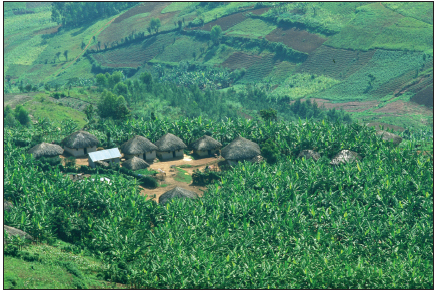 |
FAO/R. Faidutti |
FAO’s study on land tenure in Africa As a complement to the Global Forest Resources Assessment 2005 (FRA 2005), FAO carried out studies on the status of forest tenure in South and Southeast Asia (FAO, 2006b) and Africa (FAO, in preparation). These studies aimed to clarify the mechanisms that regulate the relation between tenure, tenure shifts and reform on the one hand, and sustainable forest management and poverty alleviation on the other. The objective was to provide guidance that could help governments strengthen, adapt and formulate policies that are conducive to local management of forest resources.
|
Most of the 330 million hectares of forests in Africa are publicly owned (95 percent), the majority by central governments (83 percent) (Figure 1).
| 1 Forest ownership structure |
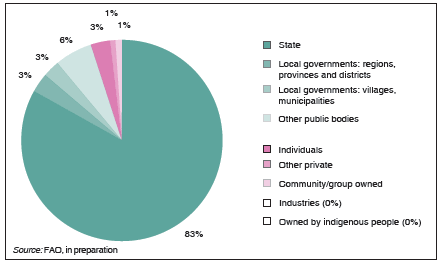 |
The government generally retains most of the responsibility for forest management either through exclusive control of forests (16 percent) or by granting non-commercial user rights to satisfy local people’s needs for forest products (61 percent) (Figure 2). User rights can include customary rights and permits or licences to hunt wildlife or gather dead wood and non-wood forest products (NWFPs). In many cases the forests are left unmanaged and uncontrolled.
There are many forms of locally based forest management, i.e. management that relies on local structures (either traditional or modern) and on local capacities and knowledge, and is therefore often able to respond better to local needs. Examples include community forestry and management by individuals or communes (townships) of forests they own.
Regionwide, local communities manage 3 percent of the forests jointly with the State and have full responsibility for 4 percent. Community-managed forests represent a significant share only in Ghana, Mozambique, South Africa and Zimbabwe.
Even though most of the forests remain State owned and managed, interesting and innovative tenure patterns are emerging in some countries.
The United Republic of Tanzania and the Gambia present two remarkable cases of effective titling (i.e. formalization or registration of a property act) of commonly owned forests. Village Land Forest Reserves and Community Forests, respectively, share a common phased implementation approach through which the governments have granted indefinite ownership of forests to local communities (see below).
| 2 Forest ownership structure |
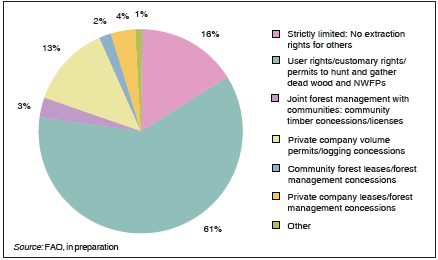 |
In Uganda, the Land Act of 1998 recognizes the possibility for individuals and communities to acquire titling certificates for private ownership (either by individuals or customary common tenure).
In Cameroon, the law makes it possible, upon the request of a village and its administrative representatives, for communes to claim forests as communal lands and to acquire their ownership. This is a step towards the devolution of public forests to local authorities.
In South Africa, different but interlinked programmes aim to reform tenure and governance in the former homelands, where land is held in trust for its occupants by the State. In 1994, the government pledged to transfer 30 percent of land owned by whites to black owners within five years. Two primary mechanisms for this transfer were put in place: restitution of land lost through racially based laws and practices, and redistribution of privately owned and public land. Alongside these programmes, the Department of Land Affairs is implementing a tenure reform programme, whose aim is to strengthen the rights of black families, groups and communities occupying land under informal systems of land tenure who have no legal status, or whose legal status is unclear.
In Mozambique, the law foresees the possibility for local communities to acquire “registered” land use rights, which are exclusive and thus empower the community to control access to the land and the resources on it. Communities receive 20 percent of the revenues collected from natural forest and wildlife exploitation and must be consulted before any land or resource can be granted to an outside concessionaire. The consultation process gives local communities the opportunity to negotiate benefits.
These six countries propose an alternative to State forest management based on the principle of locally based forest management. The following examples show how successful and powerful some of these changes can be, and summarize the requirements for their success or constraints that may lead to failure.
Common property is a customary tenure system that regulates access, use and conservation of land and natural resources to communities in many African countries. Governments often face the choice of either individualizing ownership of these resources, which risks excluding the poor, or empowering communities to govern them. Because common property management is complex in comparison with individual ownership, if the State offers this option it needs to empower communities through legal provisions, institutional arrangements, capacity building for decision-making and enforcement, and recognition of indigenous systems – including customary tenure – that can contribute to sustainable use of resources (Mwangi, 2006).
Government land titling programmes do not always provide stronger security than customary laws, and may even be a source of insecurity for women and poor households which may have limited capacity to register land (Meinzen-Dick and Di Gregorio, 2004). However, at least two examples demonstrate how formalizing common property and power sharing between government forest administrations and local communities can have a positive impact on sustainable forest management: the Village Land Forest Reserves in Tanzania and community forestry in the Gambia.
In the United Republic of Tanzania, a village council may reserve common land as a Village Land Forest Reserve for the purpose of forest management. The village council owns and manages the trees through a village natural resource committee, other group or individual, and most of the costs and benefits of managing and utilizing the forest resources are carried by the owner (Ministry of Natural Resources and Tourism, United Republic of Tanzania, 2006). The central government has a minimal role in the management of these reserves, and district councils are responsible for their establishment and related planning, as well as for occasional monitoring of the community’s implementation of the management plan. To declare a Village Land Forest Reserve, the village prepares a management plan, which must be approved by the village assembly. Villages can make bylaws to support the plan, which provide the legal basis for enforcing forest management rules. The following are some of the incentives that the Forest Act (2002) provides to encourage local communities to reserve forest resources.
As a result of these incentives, communities’ interest in establishing community-based forest management is increasing. Evidence is mounting that the condition of forests is significantly improved when they are managed locally by mandated village institutions under community-based forest management arrangements.
In the Gambia, State forests are divided into forest parks and forest reserves. A village or group of villages can become involved in community forest management by concluding an agreement with the Forestry Department over any piece of forest land that is not a forest park and that lies within the traditional lands of the village or group of villages.
The participatory forest management programme is implemented in phases. The timing for transfer to community ownership depends largely on the experience and readiness of the community concerned. Phased implementation is useful because it gives the partners the chance to build confidence and trust in each other.
The responsibilities transferred to the local community must be commensurate with its technical and managerial capacity to manage the forest sustainably. The process of ownership transfer must therefore include regular training sessions to build community capacity in such areas as group formation, participatory forest management planning, monitoring and evaluation, accounting, silvicultural techniques and marketing.
The management of a community forest is based on an approved forest management plan developed by the local management committee with the help of governmental forestry field staff. There are two types of plan, corresponding with the preliminary and consolidation phases of the community forestry implementation process: the three-year preliminary management plan and the five-year community forest management plan.
The Forestry Department evaluates the community’s management performance before the end of the preliminary phase. If the evaluation results are positive, the final Community Forestry Management Agreement is established, which leads to the community’s permanent ownership of the forest. During this three-year period, the Forestry Department provides capacity building to the local forest management committee, including training on record-keeping and bookkeeping to enhance financial management by the committee.
The programme has had documented positive effects on forest cover, frequency of forest fires, gender equity, income generation through commercialization of forest products, governance, capacity building and the promotion of an integrated rural development approach (Government of the Gambia and GTZ, 2003).
| Community forests in the Gambia are managed based on an approved forest management plan developed by the local management committee with the help of governmental forestry field staff |
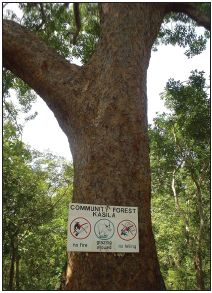 |
FAO/S. Grouwels |
Although different, the two processes described above share some common key elements.
Both programmes have demonstrated a clear positive impact in terms of sustainability of forest management, improvement of forest condition, increased sense of ownership and responsibility, and reduced conflicts between government and communities. Both approaches are rooted in a process of power sharing and capacity building, rather than simply allowing communities increased access to the forest resource.
The main limitations so far have been high costs and therefore partial dependence on external funds in the case of the Gambia; and the existing poor condition of the forests devolved to community management in the United Republic of Tanzania, which has hindered the contribution to poverty alleviation.
The contribution of clear forest tenure to poverty reduction depends on the type and security of tenure arrangements. Where tenure is long-term and secure, people have the confidence and vested interest to make investments in forestry that will have positive impacts on their lives and on the resource (Alden Wily, 2001). In the Gambia, the Forest Act recognizes the communities’ full ownership and rights in their traditional forest land, and the Local Government Act promotes community participation in the implementation of micro-projects and management of local resources (FAO, 2005). The FAO-supported Market Analysis and Development approach [ed. note: see p. 34] has assisted in the creation of small-scale forest-based enterprises, managed by local forest committees. Their success has been possible because of the legal and policy environment that enables local populations to manage forest lands sustainably and derive income from them.
| In the Gambia, transfer of forest ownership to communities involves regular training sessions to build community capacity |
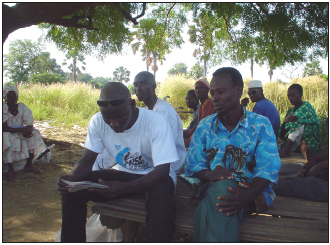 |
FAO/S. Grouwels |
Limited financial, technical or human capacities of stakeholders involved in tenure reform are among the most common constraints to tenure diversification and consolidation. A further general limitation, common to many countries in Africa, is ineffective flow of information and poor communication about the reform, hampered by the use of overly complex language or inappropriate media. These constraints limit the ability of various key players to adhere to legal requirements foreseen in the reform – for example, to develop management plans, conduct forest inventories and request and register land titles.
Some potentially successful programmes such as the land titling in Uganda and the redistribution and reallocation in South Africa have been hindered by the failure of extension services and local administrations to provide the beneficiaries of the reform with adequate assistance to exercise and retain the rights, responsibilities and opportunities associated with the reform.
The land restitution and redistribution programmes in South Africa have lagged considerably behind their targets. In most of the transfers that have taken place, the beneficiaries have been unable to establish viable enterprises or even to support themselves on the land. A lack of post-transfer support has been identified as one of the main reasons for the failure of land reform projects.
Beneficiary communities often comprise the least educated and least economically active sectors of society, and they lack experience and skills in technical aspects of production and business management. In many cases, there is a need to set up local institutions to govern community or group relations. Lack of support for building and maintaining effective local institutions is a major factor hindering the groups’ ability to manage the natural resources on their newly acquired land, including forests.
In addition to limited capacities and resources, another obstacle to a successful tenure shift has been the antagonism of local communities towards local administrations and authorities created as part of the reform. The government created these new structures to promote democratic governance at the local level and to decentralize responsibility for administrative functions and service provision. However their creation provoked a storm of protest from traditional authorities, who feared that reformed local governance and land administration might strip them of most of their powers and privileges. The conflict between new local government structures and traditional authorities has resulted in considerable chaos regarding systems for managing and allocating land rights, setting back the implementation of the reform.
Uganda’s Land Act of 1998 allows communities to acquire land legally by forming Community Land Associations which can own the land. This provision was expected to promote responsible management of natural assets on the land, reduce degradation, promote sustainable forest management and help communities alleviate poverty. Unfortunately, no applications have been made to obtain registered landownership certificates. Impediments have included discouragement from politicians and an absence of proper guidelines for registration procedures. The lack of support has penalized poorer, less educated and generally marginalized people most heavily.
| In Uganda, community associations or individuals can acquire title to land, but a lack of guidelines and support has discouraged poor and marginalized people from seeking landownership certificates |
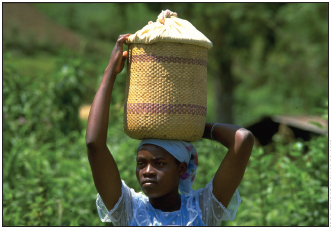 |
FAO/CFU000363/R. Faidutti |
Secure tenure has much potential to contribute to reducing forest degradation and destruction. If this potential is to be realized, governments should give far greater emphasis to supporting local users, particularly disadvantaged groups, and to providing appropriate legislation.
Experience demonstrates that security of tenure is a necessary but not sufficient condition for effective forest management. For example, where the institutional framework is weak, the devolution of forest management responsibilities to individuals or communities is bound to fail.
In many African countries, changes towards locally based forest management have had concrete results only when reform has been carried out with adequate institutional support, capacity building and timelines. The case studies summarized above illustrate how ongoing and future forest tenure reforms need to address the following priority issues.
Clear, secure and diversified forest tenure systems are fundamental to sustainable forest management and rural livelihoods based on sustainable use of forest products. However, most current policies and legal frameworks continue to limit access to forest resources.
Evidence is emerging that in many countries in Africa, tenure arrangements that provide tangible rights to local users are more conducive than full State control of forests to sustainable forest management and livelihood improvement.
A number of African countries have reformed tenure systems to support locally based forest management. Experience suggests that the process of implementing tenure reform is as important as the tenure arrangement itself. It is critical to allocate sufficient time, to identify all stakeholders involved and the steps to be taken, and to create a monitoring system that allows for “learning by doing”.
A secure and diversified tenure system that takes into account the country’s particular socio-economic context and stakeholders’ capacities, and where multiple stakeholders share responsibilities and benefits, can help to mobilize investment and ensure social as well as environmental sustainability.
![]() Bibliography
Bibliography
Alden Wily, L. 2001. Forest management and democracy in East and Southern Africa: lessons from Tanzania. Gatekeeper Series No. 95. London, UK, International Institute for Environment and Development (IIED).
Bruce, J.W. 2004. Strengthening property rights for the poor. In R. Meinzen-Dick and M. Di Gregorio, eds. Collective action and property rights for sustainable development. Washington, DC, USA, International Food Policy Research Institute (IFPRI).
FAO. 2005. Empowering communities through forestry: community-based enterprise development in the Gambia, by A. Dampha and K. Kamara. Forestry Policy and Institutions Working Paper No. 8. Rome.
FAO. 2006a. GlobalForest Resources Assessment 2005 – progress towards sustainable forest management. FAO Forestry Paper No. 147. Rome.
FAO. 2006b. Understanding forest tenure in South and Southeast Asia. Forestry Policy and Institutions Working Paper No. 14. Rome.
Government of the Gambia & German Agency for Technical Cooperation (GTZ). 2003. Impact monitoring and assessment of community forestry in the Gambia. Banjul, the Gambia, Gambian German Forestry Project & Central River Division Forestry Project.
Hobley, M. 2007. Where in the world is there a pro-poor forest policy and tenure reform? Washington, DC, USA, Rights and Resources Initiative.
Meinzen-Dick, R.S. & Di Gregorio, M., eds. 2004. Collective action and property rights for sustainable development. 2020 Vision Focus No. 11. Washington, DC, USA, IFPRI.
Ministry of Natural Resources and Tourism, United Republic of Tanzania. 2006. Participatory forest management in Tanzania – facts and figures. Dar es Salaam.
Mwangi, E., ed. 2006. Land rights for African development: from knowledge to action. CAPRi Policy Brief. Washington, DC, USA, Consultative Group on International Agricultural Research (CGIAR) Systemwide Program on Collective Action and Property Rights (CAPRi).
United Nations Development Programme (UNDP), United Nations Environment Programme (UNEP), World Bank & World Resources Institute (WRI). 2005. World resources 2005 – the wealth of the poor – managing ecosystems to fight poverty. Washington, DC, WRI.